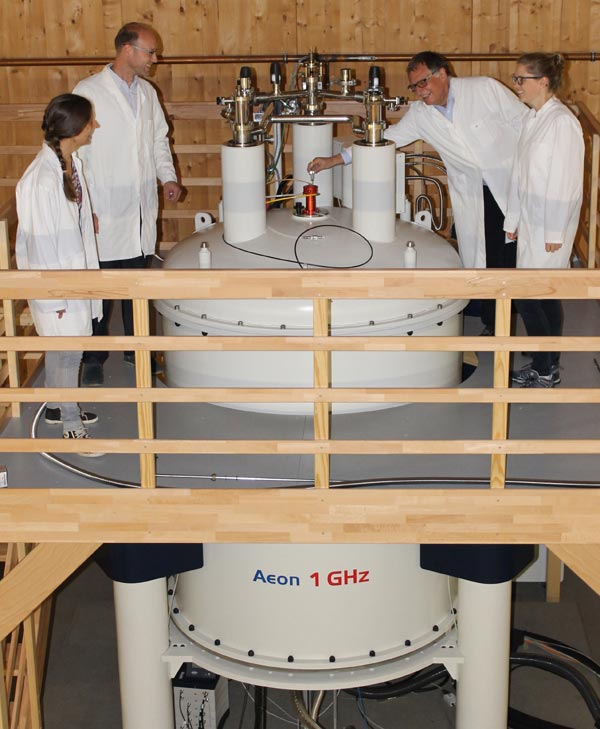Cutting-edge technology – research on new drugs at gigahertz magnetic field

Rösch (second from the right) and members of his team insert a protein sample into the magnet of the 1 GHz spectrometer in order to study the protein's conformation. Photo: Jürgen Rennecke/press office University of Bayreuth
“The potential for basic and applied research in the field of molecular medicine based on structural biology techniques at the University of Bayreuth is tremendous, in particular considering the size of this university”, to quote Prof. Dr. Paul Rösch, Chair of Biopolymers and Director of the Research Center for Bio-Macromolecules (BIOmac) at the University Bayreuth.
Rösch proudly points out the most recent results in several key areas:
Although antiviral therapies against HIV, the virus that causes AIDS, exist, the disease is not curable, and virus varieties emerge that are resistant to current drugs. “With the aid of NMR-spectroscopy at 1-GHz we are probing viral proteins such as reverse transciptase that are essential to the viral life cycle to create a structural basis for the development of innovative inhibitors of the enzyme”, Rösch states.
The spectrometer is also used to investigate the huge protein RNA-polymerase (RNAP) that is responsible for the replication of bacteria and proteins that regulate RNAP activity. “The results from these studies are the structural basis for a targeted design of new therapeutics”, Rösch says. “We strive to be on the forefront in the fight against microbes resistant to current antibiotics.”
Allergy research is another focus of structural biology based on NMR-spectroscopy in Bayreuth. The conformation and dynamics of protein allergens and their complexes with small molecules can be determined very precisely with the 1-GHz spectrometer. From these results modifications that transform allergenic proteins into non-allergenic varieties can be suggested, which, in turn, may eventually be used in immune therapy or other approaches.
The NMR data obtained at 1 GHz also enables detailed views of various complexes of allergenic proteins, thus paving the way to understand their so far largely unknown physiological functions. This may finally lead to the substitution of allergenic proteins by non-allergenic ones in plants and foods.
“This spectrometer and the expertise of our researchers made us one of the leading facilities in the field of structural biology and molecular medicine worldwide. In addition to an internationally recognized center of NMR-spectroscopy for structural biology, we are home to distinguished scientists in protein X-ray crystallography, rendering the University of Bayreuth internationally competitive in these research areas”, as Prof. Dr. Stefan Leible, president of the University of Bayreuth, explains. He adds: “This new spectrometer along with the unique expertise in structural biology present at the University of Bayreuth create a fantastic outlook for basic as well as applied research.”
Dr. Ludwig Spaenle, Bavarian State Minister of Education and Culture, Science and the Arts, confirms: “The 1-GHz NMR-spectrometer is an investment of outstanding scientific quality and national importance. The University of Bayreuth once again shows that – at least in Bavaria – even small universities are capable of achieving scientific excellence and claim a prominent place in the challenging competition of scientific institutions.”
Stefan Müller, Parliamentary State Secretay at the Federal Ministry of Education and Research, stresses: “The joint investment in this new NMR instrument by the Federal Republic and the State of Bavaria definitely furthers structural biology in Germany and beyond. This technology is among the most important of our times, it has the potential for huge contributions towards the solution of major social challenges such as new possibilities to eliminate causes of diseases.”
Virtually all research groups in academia in the field of NMR-based structural biology supported the establishment of an internationally competitive NMR-infrastructure in Bayreuth. In addition to the University of Bayreuth, the universities of Erlangen-Nuremberg, Regensburg and Wuerzburg were the main applicants. The 12 million Euro instrumentation has been financed by the German Federal Government and the State of Bavaria.
The 1-GHz spectrometer is also part of an EU-initiative to set up a network of biophysical research institutions that makes biophysical instrumentation accessible EU-wide. Thus, not only local and regional researchers are welcome to use the instrument but colleagues from Europe and around the globe are invited to make use of its capabilities.
The BIOmac laboratory is, apart from the Institut des Sciences Analytiques (ISA) in Lyon/France, the second institution in the field of molecular medicine, structural biology and chemical research worldwide that got equipped with an NMR-spectrometer with the currently strongest magnet available for such an application: a high-resolution magnet with a field strength of 23,4 Tesla, equivalent to a proton resonance frequency of 1 GHz.
contact:
Prof. Dr. Paul Rösch
Head of Department of Biopolymers
Director of the Research Center for Bio-Macromolecules (BIOmac)
Faculty of Biology, Chemistry and Earth Sciences
University of Bayreuth
Universitätsstraße 30 / BGI
95447 Bayreuth
Germany
phone: +49 (0) 921 / 55-3540
email: roesch@unibt.de
http://www.biomac.uni-bayreuth.de
Media Contact
All latest news from the category: Life Sciences and Chemistry
Articles and reports from the Life Sciences and chemistry area deal with applied and basic research into modern biology, chemistry and human medicine.
Valuable information can be found on a range of life sciences fields including bacteriology, biochemistry, bionics, bioinformatics, biophysics, biotechnology, genetics, geobotany, human biology, marine biology, microbiology, molecular biology, cellular biology, zoology, bioinorganic chemistry, microchemistry and environmental chemistry.
Newest articles

First-of-its-kind study uses remote sensing to monitor plastic debris in rivers and lakes
Remote sensing creates a cost-effective solution to monitoring plastic pollution. A first-of-its-kind study from researchers at the University of Minnesota Twin Cities shows how remote sensing can help monitor and…

Laser-based artificial neuron mimics nerve cell functions at lightning speed
With a processing speed a billion times faster than nature, chip-based laser neuron could help advance AI tasks such as pattern recognition and sequence prediction. Researchers have developed a laser-based…

Optimising the processing of plastic waste
Just one look in the yellow bin reveals a colourful jumble of different types of plastic. However, the purer and more uniform plastic waste is, the easier it is to…



